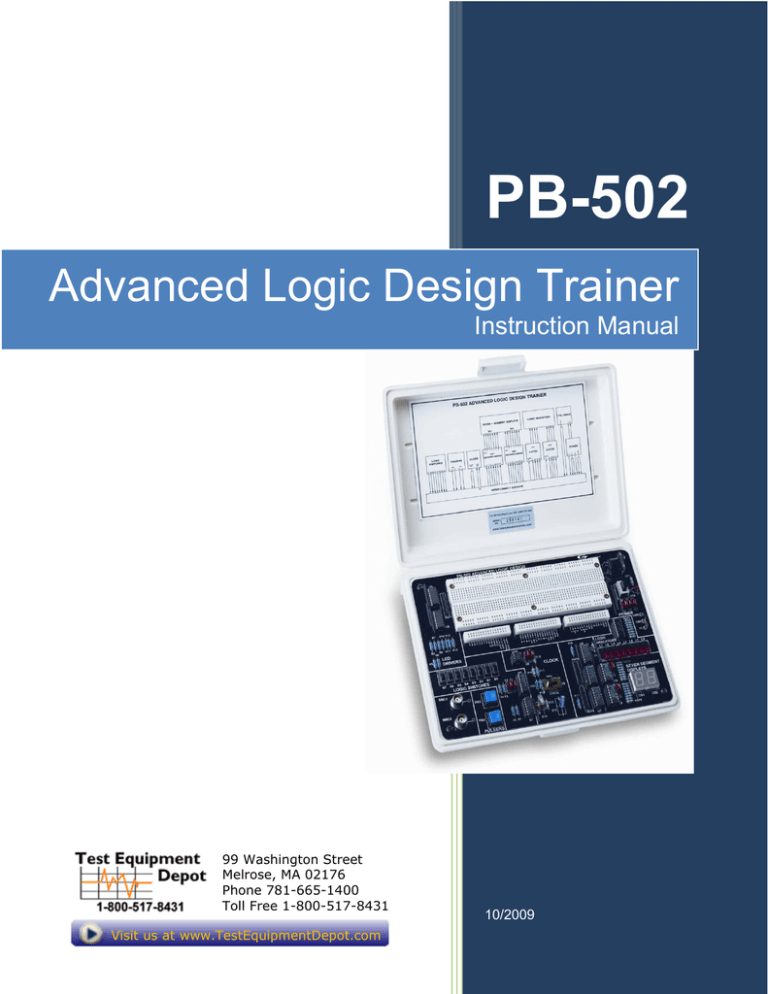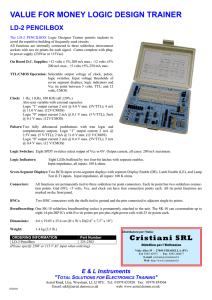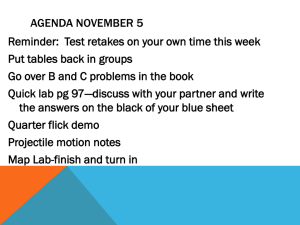
PB-502
Advanced Logic Design Trainer
Instruction Manual
99 Washington Street
Melrose, MA 02176
Phone 781-665-1400
Toll Free 1-800-517-8431
Visit us at www.TestEquipmentDepot.com
10/2009
2
All rights reserved. No Part of this book shall be reproduced, stored in a retrieval
system, or transmitted by any means, electronic, mechanical, photocopying recording,
or otherwise, without written permission from the publisher. No patent liability is
assumed with respect to the use of the information contained herein. While every
precaution has been taken in the preparation of this book, the publisher assumes no
responsibility for errors or omissions. Neither is any liability assumed for damages
resulting from the use of the information contained herein.
Global Specialties specifically warns the user of this instrument that it is intended for
use in a classroom or laboratory environment for the purpose of learning and
experimentation. When building experimental circuits, it may emit interference that will
effect radio and television reception and the user may be required to stop operation until
the interference problem is corrected. Home use of this equipment is discouraged since
the likelihood of interference is increased by the close proximity of neighbors.
CORRECTIVE MEASURES:
Interference can be reduced by the following practices.
1)Install a commercially built RFI power filter in the power line at the point where the
cord enters the unit.
2)Avoid long wires. They act as antennas.
3)If long wires must be used, use shielded cables or twisted pairs which are properly
grounded and terminated.
3
ABOUT GLOBAL SPECI ALTIES
Thank you for selecting this Global Specialties product. You won't be disappointed!
Since 1973, Global Specialties has been the recognized leader in technical education
courses, training equipment and tutorial materials. Our electronics and microcomputer
teaching systems have proven to be effective in secondary schools, technical schools,
colleges, universities and industrial training departments throughout the world.
We have been leaders in the development of integrated teaching systems and
completely packaged courses which include everything required for effective
instruction. Comprehensive textbooks and laboratory manuals have been written in
a comfortable, non-intimidating style by experienced professional educators,
specifically for use with our equipment.
Each course is designed to make selections appropriate for a variety of educational
levels and course goals. Instructor's guides, audiovisual aids and other
enhancements provide additional teaching efficiency and flexibility.
The central concept upon which we base our entire product line is education
through application. We believe that relevant scientific and technical education is
best when it involves permitting students to learn by actually doing. Our courses,
equipment, instruments and tutorials have been developed with the hands-on
approach.
You can count on Global to stand behind every product we sell. We offer a full
three-year parts and labor warranty on every assembled product in our line. This
means that any Global product which performs improperly can be returned for
prompt repair or replacement, with no questions asked. Low per-student cost,
durable and trouble-free hardware and proven tutorial materials combine to make
technical and scientific courses from Global Specialties the most effective,
economical way to upgrade your lab & curriculum.
4
TABLE OF CONTENTS
Product Description…………………………………………………….page 6
Specifications…………………………………………………………...page 7
Description of Operating Controls and Major Components………..page 9
Operating Precautions…………………………………………………page 12
PB-502 Checkout………………………………………………………page 13
Service Information……………………………………………………page 17
5
PRODUCT DESCRIPTION
The PB-502 is an instrument capable of satisfying the many requirements arising in the
design and study of analog and digital circuitry. The instrument contains three integral
power supplies and input/output devices that simplify the construction of a wide range
of circuits. Typical circuits that can be built on the PB-502 include, operational
amplifiers, comparators, A to D converters, gates and counters. The PB-5022 can even
interface directly to a microprocessor.
The PB-502 contains eight LED logic indicators, eight logic switches and two BCD input seven-segment displays. It also contains a clock with three switch-selectable
output frequencies, and three power supplies. The power supplies are +12 volts, +5
volts and -12 volts.
The logic indicators on the PB-502 can serve two functions. They may be used either as
eight "real time" logic probes or as two latchable four-bit logic indicators.
All of the PB-502 functions mentioned above are internally connected to three
solderless interconnect sockets with two tie points for each signal. In addition, a UBS100 solderless breadboarding socket is permanently attached to the unit. It provides a
convenient work area for the circuitry being designed or studied. All sockets allow
insertion of components or wires up to 22 gauge.
A wall adapter type power supply is used to generate the regulated voltages used on
the PB-502. Power supply connections to the instrument are made via the five (5) pin
DIN connector.
The PB-502 is housed in a durable and attractive case with a hinged protective cover.
This makes the unit portable and stackable for storage purposes.
6
SPECIFICATIONS
Input Power Source
Regulated wall mount adapter
with outputs of +/-12VDC @
200mA, 5VDC @ 250mA
Power Supplies
Select either 5V TTL or 12V
CMOS operation via jumper wire
connection
Fixed DC: 12VDC @ 200mA +/5% Fixed - (-)12VDC @ 200mA
+/- 5%
Fixed DC: 5VDC @ 250mA +/5%
Clock
Frequency: Fixed at three levels:
1hz +/- 20%, 1Khz +/- 20%,
100khz +/- 20%
User variable with use of
external capacitor
Pulsers
(2) Fully debounced
pushbuttons with logic true and
complementary outputs
Logic '1" output current 2mA @
4V min (5V TTL)
Logic '1" output current 4mA @
11V min (12V CMOS)
Logic "0" output current 2mA
max @ 0.1V max (5V/TTL)
Logic "0" output current 5mA
max @ 0.1V max (12V/CMOS)
Logic Switches
(8) SPDT switches select output
of Vcc or ground (0V). Output
current is 200mA max in all
cases
Logic Indicators
(8) LEDs buffered by two 4-bit
latches with separate enables.
Input impedance 100k ohms in
all cases
Selectable Operating
Voltage
7
Connectors
(2) BNC – uncommitted
Displays
(2) BCD-input seven segment
displays with separate Display
Enable (DE). Latch Enable (LE),
and Lamp Test (LT) inputs.
Input impedance 100K ohms
Breadboards
Weight
Dimensions
840 tie points with (8) 25 pin
power rails and accommodates
up to 8 (14 pin) ICs
1 lb, 6oz (minus adapter)
10" x 7.5" x 2.6"
8
DESCRIPTION OF OPERATING CONTROLS AND MAJOR
COMPONENTS
In order to properly use the full capabilities of the PB-502, it is highly recommended that
the user become familiar with the controls associated with this instrument.
Power Receptacle
Five (5) pin DIN type receptacle power supply connection..
Power Switch
Push power switch S10 up to apply power to the PB-502, move switch back to turn
power off. LED Dl lights to show power ON condition.
CMOS/TTL Switch
Selector S8, is made up of three individual breadboarding tie points, and determines the
operating voltage of the PB-502 circuitry. For 12 volt operation, install a jumper wire
from the center tie point to the upper tie point labeled CMOS. In this condition, the
output amplitude of the Logic Switches, Pulsers, Clock, and Vcc tie point is 12 volts, and
the input thresholds to the Seven-Segment displays and Logic Indicators are set to 12
volts CMOS levels.
For 5 volt operation, install the jumper wire from the center tie point to the lower tie
point labeled TTL. This will cause the output amplitude of the Logic Switches, Pulsers,
Clock, and Vcc tie point to be 5 volts, and the input thresholds to the Seven Segment
Displays and Logic Indicators to be set to levels usable for TTL or CMOS operating at 5
volts.
CAUTION
A jumper must be installed selecting either the CMOS or
TTL position before power is applied, and power must be
removed when it is desired to change the selection.
Logic Indicators
The eight LEDS L0-L7, are used for indicating logic states of circuit points. A logic 1 on
a logic indicator input will light its corresponding LED. In addition, the logic indications
can be latched to freeze the states shown; a high-to-low transition on Clock X will latch
LEDs LO through L3, and a high-to-low transition on Clock Y will latch LEDs L4 through
L7. While Clock X or Clock Y remain low, the logic indications will remain latched;
bringing these points high will restore the indicators to a real time display.
Seven-Segment Displays
DS1 and DS2 are two independent seven-segment numeric displays. These are
enabled, or turned on, by applying a logic 1 to the Display Enable tie-points DS1DE for
DS1, DS2DE for DS2. When enabled, the displays will show a zero if no other inputs
are present. Numbers are displayed by applying a logic 1 to the D, C, B and A tie-points
in BCD, from 0000 to 1001. Input of 1010 or greater will cause the display to blank. The
9
number displayed can be latched by a low-to-high transition on the LE (Latch Enable)
input. This latched condition will exist as long as a logic 1 is maintained; when LE is
returned to a logic 0, or low, the displays will be restored to their real time status. At any
time the displays are enabled, a Lamp Test can be performed by applying a logic 0 to
the LT tie point associated with the display. This will confirm the proper functioning of
each display by lighting all LED segments.
Frequency Switch
The three position frequency switch, S9, is used to select the output frequency of the
clock. This output is available as either 1Hz, 1kHz, or 100kHz. The Clock Out amplitude
is dependent upon the jumper installed in the CMOS/TTL selector S8, being 12 volts in
the CMOS position and 5 volts in the TTL position. Frequency can also be changed by
inserting a capacitor in the EXT CAP tie points. Some representative capacitors and
their effect on a frequency are shown in Table 1.
EXTERNAL CAPACITOR
FREQ SW
SETTING
1Hz
1kHz
100kHz
0.001MF
1Hz
500Hz
50 kHz
0.01M F
1Hz
90.9Hz
9.09kHz
0.1 M F
0.91Hz
9.9HZ
990Hz
1.0 M F
0.5Hz
1HZ
100Hz
10 U F
0.091Hz
0.1Hz
10Hz
RESULTING OUTPUT FREQUENCY
Table 1: Output Frequency vs. External Capacitor Value
Pulsers
Pulsers PBI and PB2 are two fully debounced pushbuttons with true and
complementary outputs. These outputs are made available on the tie-point connector
as PB1 (trigger low), PB1 (trigger high), PB2 (trigger high) and PB2 (trigger low) . The
PB1 output will be at a logic 1 while PB1 is not pressed and will go to a logic 0 when the
switch is pressed, and return to a logic 1 when the switch is released. The PB1 (trigger
high) provides the complement of the above, that is, the point will be at a logic 0 while
the switch is not pressed, will go to a logic 1 while the switch is pressed, and return to a
logic 0 when the switch is released. The operation of PB2 is identical. In all cases, the
logic 1 value is dependent upon the jumper installed in the CMOS/TTL selector, being
12 volts in the CMOS position and 5 volts in the TTL position.
BNCS
Two additional connectors, BNC 1 and BNC 2, are provided to simplify input and output
interfacing to the PB-502. The shells of both BNCs are connected to ground, while the
pins of each individual BNC are connected to adjacent single tie points which can be
wired to the solderless breadboard using jumper wires.
10
Logic Switches
Eight SPDT logic switches SO to S7 are provided with outputs at the connector tie
points. These switches set a logic 1 to corresponding tie points when pushed up, and a
logic 0 when pulled back. The logic 1 output voltage is dependent upon the jumper
installed in the CMOS/TTL selector, being 12 volts in the CMOS position and 5 volts in
the TTL position.
Connectors
All functions are permanently tied to these three tie point connectors. Each tie point has
two solderless connection points.
Solderless Breadboard
The solderless breadboard, UBS-100 accommodates up to eight 14-pin DIP ICs with 4
tie points per pin plus 8 power rails with 25 tie points each.
11
OPERATING PRECAUTIONS
The Logic Indicators and Seven-Segment Displays are intended for use only with digital
signal inputs having voltage levels of Vcc or ground. It is, therefore, recommended that
all interfacing be done with digital circuitry operating from the Vcc tie points. Exceeding
Vcc, (12 volts with the CMOS/TTL selector jumpered to the CMOS position, 5 volts with
the jumper in the TTL position) at any input will cause circuit damage to the PB-502 as
will input voltages below ground. If necessary, input protection can be constructed on
the UBS-100 solderless breadboarding socket. This circuit should protect any input over
the voltage range of -15 to +20 volts without affecting input thresholds
12
PB-502 CHECKOUT
To check out the PB-502 the following equipment is required.
1. A dual-trace oscilloscope, 10MHz bandwidth minimum.
2. 3 ½ Digit Digital Volt Meter.
CAUTION
A jumper must be installed in selector S8from center tie
point to either the TTL or CMOS position before turning on
power. Power must also be removed each time the position
of this jumper is changed.
Procedure
Plug 5-pin DIN connector from wall adapter into J1 on the PB-502. Plug wall-mount
adapter into outlet. Turn PB-502 Power switch to ON: LED Dl will light.
Step I
Using an oscilloscope or a DMM, measure the power supply voltages present on the tie
point connector:
1.
2.
3.
4.
+12 should read between +11.4 volts and +12.6 volts.
+5 should read between +4.75 volts and +5.25 volts.
-12 should read between -11.4 volts and -12.6 volts.
Vcc should read between:
a) +11.4 volts and +12.6 volts with the CMOS/TTL switch in the CMOS
position.
b) +4.75 volts and +5.25 volts with the CMOS/TTL switch in the TTL
position.
c)
Step II
Using an oscilloscope, measure the output frequency and amplitude of the clock
out signal.
1. Set Freq switch to 1Hz.
a) Frequency should be between 0.8Hz and 1.2Hz.
b) Amplitude should be the same as Vcc levels, that is, +12volts with the
CMOS/TTL selector jumpered to the CMOS position, and +5 volts with
the CMOS/TTL selector jumpered to the TTL position.
2. Set Freq switch to 1kHz.
a) Frequency should be between 800Hz and 1.2kHz.
b) Amplitude should be +12 volts in CMOS, +5 volts in TTL.
3. Set Freq switch to 100kHz
a) Frequency should be between 80kHz and 120kHz.
13
b) Amplitude should be +12 volts in CMOS, +5 volts in TTL.
4. In all cases, duty cycle should be between 40% and 60%
Step III
Use a jumper wire to test the Logic Indicators as follows:
1. Jumper CMOS/TTL selector to CMOS.
2. Observe that all 8 LEDS are off.
3. Connect a jumper wire between the Vcc tie point and the L0 tie point.
L0 should light, all other LEDs should remain off.
4. Move the jumper wire from L0 to LI. LI should light, all other LEDs should
remain off.
5. Repeat these steps for L2 through L7.
Step IV
Use jumper wires to test the Seven-Segment Displays as follows:
1. Connect a jumper between DSIDE and +12 V.
a) DS1 should light, showing a 0.
2. Connect a jumper between DS1LT and GND.
a) All segments of DS1 should light.
3. Disconnect the jumper between DS1LT and GND.
a) DS1 should again display a 0.
4. Jumper between DS1A and Vcc.
a) A numeral 1 should be displayed on DS1.
5. Move the jumper from DS1A to DS1B.
a) A 2 should be displayed.
6. Move the jumper from DS1B to DS1C.
a) A 4 should be displayed.
7. Move the jumper from DS1C to DS1D.
a) An 8 should be displayed.
8. Leaving the jumper in DS1D, connect another jumper from DS1LE to Vcc.
a) The 8 should remain on.
9. Remove the jumper from DS1D.
a) The 8 should remain on.
10. Remove the jumper from DS1LE.
a) The display should return to 0.
11. Repeat steps 1-10 for DS2.
14
Step V.
Test the Pulsers by jumpering to L7 as follows:
1. Connect a jumper wire from PBI (trigger low) to L7
a) Logic Indicator L7 will be lit while Pulser PB1 is not pressed.
b) Pressing PB1 causes L7 to extinguish.
c) Releasing PB1 causes L7 to relight.
2.
a)
b)
c)
Move the jumper wire from PBI —U~ to PBI _TL_
Logic Indicator L7 will not be lit while PBI is not pressed.
Pressing PBI causes L7 to light
Releasing PBI causes L7 to extinguish
3. Repeat the above steps for PB2 Step V
Step VI
Test the Logic Switches by jumpering them to the Logic Indicators as follows:
2.
3.
1.
Jumper SO to LO, SI to LI, and so on, through S7 to L7
Alternately move switches SO through S7 up and back. The LED
corresponding to each switch will light when the switch is up, and extinguish
when the switch is down.
Leave all jumpers connected for the Latch test which follows.
Step VII
Test the Logic Indicator Latches as follows:
1.
2.
3.
4.
5.
If not already accomplished, jumper the Logic Switches to the Logic
Indicators as described in Step VI (1).
Move all switches to the up position. All LEDS should light. Connect
jumpers from Clock X to GND and Clock Y to GND. All LEDs should
remain lit.
Move all switches from the up to the down position. All LEDs should
remain lit.
Remove the jumper from Clock X. LEDs LO through L3 should
extinguish. LEDs L4 through L7 should remain lit.
Remove the jumper from Clock Y. LEDs LO through L3 should remain
out. LEDs L4 through L7 should extinguish.
Step VIII
Remove all remaining wires except CMOS/TTL selector jumper.
a) All displays should be extinguished.
Step IX
Turn the Power Switch OFF.
This completes the checkout procedure.
15
SERVICE AND WARRANTY INFORMATION
For instructions on how to obtain a return merchandise authorization number (RMA),
please visit our website, or call our customer service department.
99 Washington Street
Melrose, MA 02176
Phone 781-665-1400
Toll Free 1-800-517-8431
Visit us at www.TestEquipmentDepot.com
Global Specialties will service and repair this instrument free of charge for a period of 3
full years, subject to the warranty conditions below.
WARRANTY
Global Specialties warrants this device to be free from defective material or
workmanship for a period of 3 full years from date of original purchase. Under this
warranty, Global Specialties is limited to repairing the defective device when returned to
the factory, shipping charges prepaid, within 3 full years from date of original purchase.
Units returned to Global Specialties that have been subject to abuse, misuse, damage
or accident, or have been connected, installed or adjusted contrary to the instructions
furnished by Global Specialties, or that have been repaired by unauthorized persons will
not be covered by this warranty.
Global Specialties reserves the right to discontinue models, change specifications, price
or design of this device at any time without notice and without incurring any obligation
whatsoever.
The purchaser agrees to assume all liabilities for any damages and/or bodily injury
which may result from the use or misuse of this device by the purchaser, his employees,
or agents.
This warranty is in lieu of all other representations or warranties expressed or implied
and no agent or representative of Global Specialties is authorized to assume any other
obligation in connection with the sale and purchase of this device.
Specifications subject to change without notice.
16



